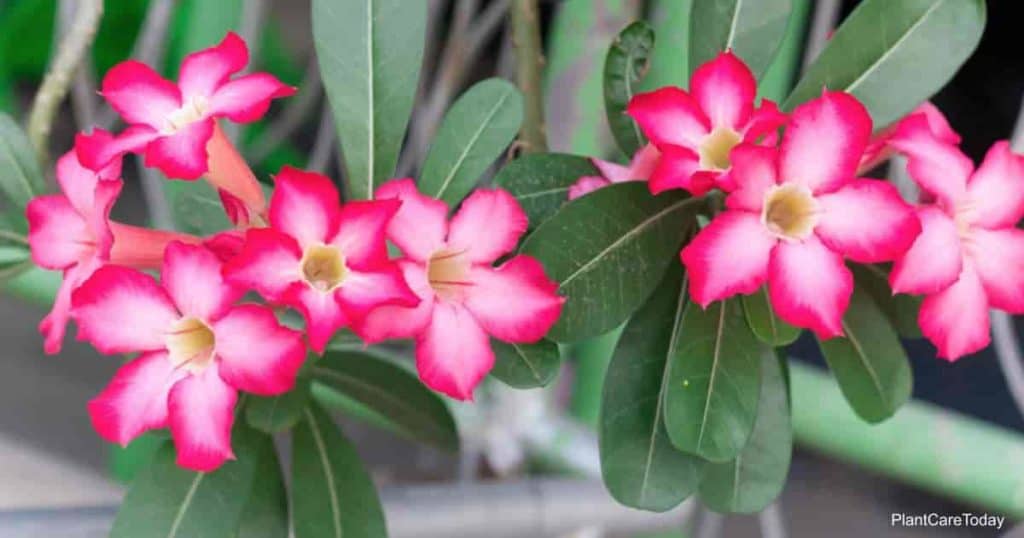Desert Rose plants are semi-succulent shrubs belonging to the family Apocynaceae, including Periwinkle plants.
It is grown as an evergreen ornamental plant in gardens and as an attractive houseplant in the USDA hardiness zone 11 in a temperate climate.
It is native to the Sahel region, situated south of the Sahara desert. But it’s also found in South Africa and Arabia’s tropical and subtropical regions, including Algeria and Tunisia.

The Desert Rose, like Adenium obesum, resembles a dwarf tree with a thick stem and a swollen base.
The ends of the crooked branches are packed with clusters of broad leaves arranged in a loose spiral formation.
Moreover, its petals are disc-like and amalgamated selenite crystals, radiating out in flattened forms.
The waxy gray bark creates a beautiful contrast with the lush green foliage and trumpet-like, showy blooms.
As suggested by its name, Desert Rose is a flowering plant that prefers to grow in the desert-like, dry season with part-shade or direct sun in well-drained soil.
Their crystals are usually formed in arid sandy conditions like deserts with sand inclusions that cause the desert rose to resemble the color.
However, the Sahara desert rose colors may vary depending on the different minerals in the sand grains. It may range from white, pink, red, brown, and sometimes black.
Under ideal conditions, the Adenium obesum reaches a height of about 5’ feet.
The occasionally hairy, often glossy, oblong leaves grow up to 9” inches in length and 2.5” inches in width, whereas the five-lobed flamboyant flowers are 2” inches in size.
Desert rose is famous by its scientific name Adenium Obesum and the following common names:
- Desert Azalea
- Mock Azalea
- Sabi Star
- Impala Lily
- Kudu Lily
- Gypsum Rose
- Sand Rose
- Selenite rose
Adeniums are well-liked as low-maintenance potting plants with beautiful flowers in shades of white, pink, magenta, and red with a prominent margin and white center that grow as bonsai or specimens.
While you might be tempted to bring this beauty home, you might have to rethink it if you have small children or pets in your house since they’re poisonous plants.
Are Desert Roses Poisonous?
The Adenium, aka Desert Rose, is included in the list of plants considered dangerously toxic to humans, dogs, cats, and horses.
The plant is known to contain potent toxins, which, if ingested in large amounts, can turn out to be lethal.

As an age-old practice, the Adenium obesum has been extensively used to prepare poisoned arrows used for hunting across Africa.
The poison is found to be extremely potent and could kill even animals as large as elephants.
Since cats and dogs are much smaller in size, even a small dose could have devastating effects.
According to the American Society for the Prevention of Cruelty to Animals (ASPCA), animals are instantly poisoned by the desert rose by ingesting a part of it or simply by licking the plant.
The larger the quantity ingested, the lower the chances of survival.
Pets allowed outdoors or exposed to gardens or indoor plants are usually tempted to snack on the plant.
Consumption of any sap-containing plant part can lead to mild symptoms or fatal clinical signs.
Related: Find out what makes the best Desert Rose Fertilizer for your Adeniums.
What Parts Of The Adenium Desert Rose Are Poisonous?
All parts of the desert rose contain sap, a highly toxic substance because the sap that flows in roots, stems, green leaves, and bark is loaded with toxic chemical agents.
The sap reportedly contains cardiac glycosides and cardioactive steroids.
The plant also consists of dangerous compounds like Hongheloside A, D, E, and F, digitalinum verum, somaline, digitalinum verum hexacetate, and digitalis-like glycosides.

Cardiac glycosides obstruct the muscles of the heart, whereas cardioactive steroids bring the heart rate to an abnormally slow pace.
These poisonous agents adversely affect the enzymes regulating the movement of ions in the body.
Consequently, the sap of the desert rose disrupts the central nervous system, gastrointestinal tract, cardiovascular system, and electrolyte levels.
What Are The Symptoms Of Poisoning?
The earliest symptoms of Adenium obesum poisoning would be experienced within 12 to 36 hours of exposure.
The symptoms of desert rose poisoning in humans include reduced heart rate, low blood pressure, lethargy, gastrointestinal problems, and dizziness.
Exposure to the sap of the plant while handling it also causes skin irritation and poisoning as it penetrates through the skin.
In cats, ingestion of desert rose would lead to symptoms like severely upset stomach, nausea, vomiting, diarrhea, loss of appetite, excessive drooling, weakness, abdominal cramps, and lack of coordination.

In more extreme cases, you will observe dilated pupils, fluctuating heartbeat (too slow or fast), low body temperature, seizures, tremors, and death.
Symptoms of toxicity in dogs may include anorexia, vomiting, diarrhea, abdominal pain, depression, excessive drooling, and mouth and throat sores.
Moreover, if the sap of plant comes in contact with the fur of the animal, it can cause blisters and skin irritation.
Related: Are Roses Toxic or Poisonous To Cats
How To Protect Yourself While Handling Desert Roses?
To ensure protection against the Adenium obesum, it is strongly advised to wear protective gloves when working with the plant, especially while pruning or trimming it.
If the sap comes in contact with any part of the body, immediately wash it off with soap water.
Keep the plant out of the reach of small children and animals.

Do not give your pets access to the area where Adenium obesum has been planted.
If growing it indoors, keep it high enough.
Take your pet to the nearest veterinary clinic or contact an emergency animal poison control center if you suspect your pet has chewed any part of the Adenium obesum plant.
Do not wait for the symptoms to become apparent. Early treatment increases the chances of survival.
source: 1 | 2